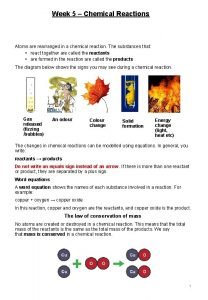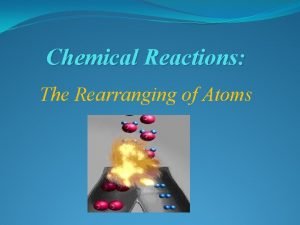Week 5 Chemical Reactions Atoms are rearranged in






- Slides: 6

Week 5 – Chemical Reactions Atoms are rearranged in a chemical reaction. The substances that: • react together are called the reactants • are formed in the reaction are called the products The diagram below shows the signs you may see during a chemical reaction. Gas released (fizzing /bubbles) An odour Colour change Solid formation Energy change (light, heat etc) The changes in chemical reactions can be modelled using equations. In general, you write: reactants → products Do not write an equals sign instead of an arrow. If there is more than one reactant or product, they are separated by a plus sign. Word equations A word equation shows the names of each substance involved in a reaction. For example: copper + oxygen → copper oxide In this reaction, copper and oxygen are the reactants, and copper oxide is the product. The law of conservation of mass No atoms are created or destroyed in a chemical reaction. This means that the total mass of the reactants is the same as the total mass of the products. We say that mass is conserved in a chemical reaction. 1

Test yourself Task 1: Identify whether the following pictures show a physical or chemical change. Mark the chemical reactions with a tick. Task 2: Complete the questions below. 1. When carbon burns it combines with oxygen to form carbon dioxide. The diagram shows some carbon atoms reacting with some oxygen molecules. a) Finish the diagram by drawing the correct number of carbon dioxide molecules. One has been done for you. b) c) Write ‘reactants’ and ‘products’ under the correct sides of the diagram. 12 g of carbon reacted with 32 g of oxygen. What mass of carbon dioxide was formed? Circle the correct answer. 12 g 24 g 32 g 44 g 64 g 2. Match up the following statements. If a gas combines with a solid or liquid appear to decrease in mass Reactions that release gas the mass will stay the same Conservation of mass states that the mass of reactants and products the mass will appear to increase If a substance melts, should be exactly the same When two liquids react, the mass of each liquid will add together 2

The reactivity series In a reactivity series, the most reactive element is placed at the top and the least reactive element at the bottom. A reactivity series of metals could include any elements. The diagram on the right shows the reactivity series. Observations of the way that these elements react with water and acids enable us to put them into this series. The tables below show the elements react with water and dilute acids: Metals in water The word equations and symbol equations for the reaction of group 1 metals with acids is on page 19 (L 3: Properties of group 1 metals and how they react) Metals in acids The general rule for metals reacting with acids is shown below. 3

Test yourself Task 1: Look Say Cover Write Check Look example Say Cover Write exampel Check Write example Check Potassium Sodium Lithium Calcium Magnesium Aluminium Zinc Iron Carbon Hydrogen Copper Task 2: Answer the following questions 1. The general word equation for the reaction between metal and water is: 2. The general word equation for the reaction between metal and hydrochloric acid is: 3. How can you test for hydrogen? 4. Complete the following word equations: 4

Displacement reactions A more reactive metal will displace a less reactive metal from a solution of one of its salts. For example: magnesium + copper(II) sulphate → copper + magnesium sulphate Mg(s) + Cu. SO 4(aq) → Cu(s) + Mg. SO 4(aq) Test yourself Task 1: Work out which metal is more reactive (use the reactivity series on page 27 to help you). Number Metal 1 vs. Metal 2 The most reactive metal wins 1 Lead vs. Zinc 2 Magnesium vs. Hydrogen 3 Calcium vs. Iron 4 Copper vs. Gold 5 Silver vs. Calcium 6 Potassium vs. Carbon 7 Carbon vs. Calcium 8 Hydrogen vs. Carbon 5

Task 2: Complete the table. Number 8 and 9 are challenge questions. Compound + Metal Displacement or No Displacement Explanation 1 Magnesium Chloride + Sodium Chloride + Magnesium Sodium is more reactive Magnesium 2 Potassium Chloride + Iron No displacement Potassium is the most reactive metal 3 Zinc Chloride + Iron 4 Aluminium Chloride + Calcium 5 Copper Chloride + Silver 6 Calcium oxide + Zinc 7 Aluminium oxide + Zinc Hydrogen Challenge 8 Iron oxide + 9 Gold oxide + Carbon 6











